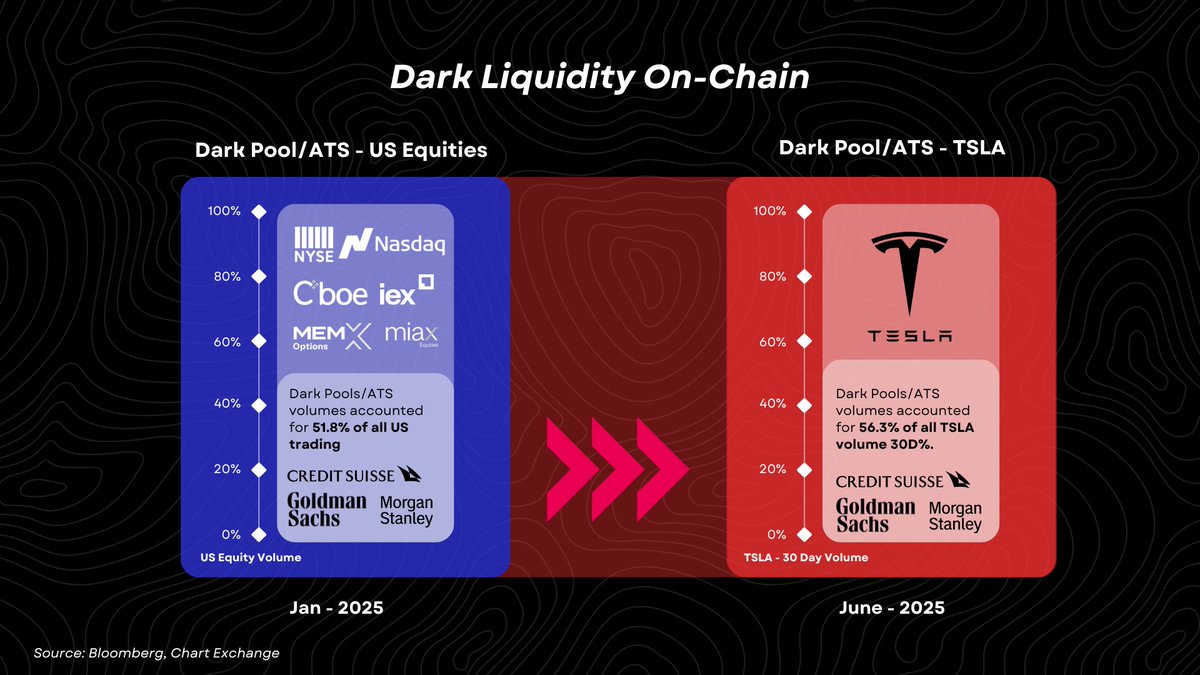If Dark AMMs reach PMF on-chain they will dominate spot volume on @solana
On-Chain Dark Pools: A Global Race🕳️💧
Dark Pools/ATS are increasingly becoming a massive percentage of stock trading in TradFi. But they don’t exist in crypto yet, or if they do, they are built for niche use cases or on the wrong tech stacks.
The goal is the ability to trade privately on-chain with zero slippage, no MEV, and CEX-level execution.
We don’t need to rewrite the playbook, this has existed since the 1980s in TradFi.
A dark pool is a private trading venue where institutions execute large trades without either party(s) showing their hands. Orders are hidden until matched, so there’s no front-running, back-running, slippage, or price impact. It’s how serious money from BlackRock, Citadel, Millennium, Jane Street, Vanguard, Fidelity, etc. avoids moving the market.
As Bloomberg says: “Wall Street Enters Darker Age With Most Stock Trading Hidden.” This isn’t a niche. Trillions in U.S. equities trades through dark pools every year, with Goldman’s Sigma X, MS’s MS Pool, and Credit Suisse’s Crossfinder dominating flows.
As of January 2025, nearly 51.8% of U.S. stock trading is now done off-exchange via dark pools or ATS (alternative trading systems). With certain stocks, off-exchange activity can spike significantly higher.
For example, over the last 30 days, approximately 56.3% of TSLA trading volume was routed off-exchange, primarily through dark pools.
Institutional players are increasingly viewing the public markets and on-chain markets as hostile environments and prefer the neutrality and simplicity of dark pools.
So why haven’t dark pools made it to crypto and DeFi? Because most blockchains simply aren’t built to support them. While some (like @solana and @Aptos) now offer confidential transfers that hide transaction amounts, the sender and receiver addresses remain public meaning the trade itself still reveals critical data can be re-ordered in some scenarios.
True dark pools require full privacy (counterparties, price, and intent) along with fast, scalable settlement and most chains fall short on both fronts.
On top of that, most chains are highly incentivized to allow MEV (maximal extractable value). This means that large orders are routinely front-run, reordered, or sandwiched before they can settle, which is a serious hindrance and risk for institutional participants.
Recently, Hyperliquid has showcased that traders are willing to move to no-KYC platforms with deep liquidity, but there are issues with the level of visibility that takes place on @HyperliquidX.
On the one hand, extra transparency can improve execution and increase non-toxic flow. On the other hand, it can lead to situations like we saw with @JamesWynnReal, where market makers were willing to size up as they knew who it was but if they were trading against Jane Street, it would be a different ball game.
However, I see a potential path where existing players like Aptos, Solana, Sui or a new player building on top of a high-throughput chain who has one half of the puzzle (fast finality, parallel execution, low latency, etc.) could prioritize a bespoke matching engine or encrypted order routing. That would make dark pools viable on-chain.
Essentially, certain chains will continue down the path of optimizing for increased volumes via trading activity while simultaneously enabling institutional players to onboard and utilize dark pools as a refuge from on-chain market games and toxic order flow.
The second half of the journey toward massively increasing on-chain volumes is dark liquidity driven by institutional players.
If you're building this hmu.

3.79K
0
The content on this page is provided by third parties. Unless otherwise stated, OKX is not the author of the cited article(s) and does not claim any copyright in the materials. The content is provided for informational purposes only and does not represent the views of OKX. It is not intended to be an endorsement of any kind and should not be considered investment advice or a solicitation to buy or sell digital assets. To the extent generative AI is utilized to provide summaries or other information, such AI generated content may be inaccurate or inconsistent. Please read the linked article for more details and information. OKX is not responsible for content hosted on third party sites. Digital asset holdings, including stablecoins and NFTs, involve a high degree of risk and can fluctuate greatly. You should carefully consider whether trading or holding digital assets is suitable for you in light of your financial condition.

